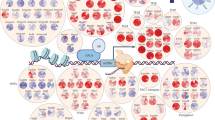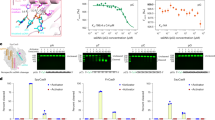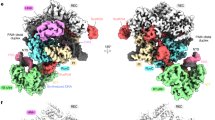Abstract
Eukaryotic poly(A) signals direct mRNA 3′-end processing and also pausing and termination of transcription. We show that pausing and termination require the processing factor CPSF, which binds the AAUAAA hexamer of the mammalian poly(A) signal. Pausing does not require the RNA polymerase II C-terminal domain (CTD) or the cleavage stimulation factor, CstF, that binds the CTD. Pull-down experiments show that CPSF binds, principally through its 30-kDa subunit, to the body of the polymerase. CPSF can also bind CstF, but this seems to be mutually exclusive with polymerase binding. We suggest that CPSF, while binding the body of the polymerase, scans for hexamers in the extruding RNA. Any encounter with a hexamer triggers pausing. If the hexamer is part of a functional poly(A) signal, CstF is recruited and binds CPSF, causing it to release the polymerase body and move (with CstF) to the CTD.
This is a preview of subscription content, access via your institution
Access options
Subscribe to this journal
Receive 12 print issues and online access
$189.00 per year
only $15.75 per issue
Buy this article
- Purchase on Springer Link
- Instant access to full article PDF
Prices may be subject to local taxes which are calculated during checkout






Similar content being viewed by others
References
Gavin, A.C. et al. Functional organization of the yeast proteome by systematic analysis of protein complexes. Nature 415, 141–147 (2002).
Calvo, O. & Manley, J.L. Strange bedfellows: polyadenylation factors at the promoter. Genes Dev. 17, 1321–1327 (2003).
Proudfoot, N. New perspectives on connecting messenger RNA 3′ end formation to transcription. Curr. Opin. Cell Biol. 16, 272–278 (2004).
Rosonina, E., Kaneko, S. & Manley, J.L. Terminating the transcript: breaking up is hard to do. Genes Dev. 20, 1050–1056 (2006).
Ansari, A. & Hampsey, M. A role for the CPF 3′-end processing machinery in RNAP II-dependent gene looping. Genes Dev. 19, 2969–2978 (2005).
Hammell, C.M. et al. Coupling of termination, 3′ processing, and mRNA export. Mol. Cell. Biol. 22, 6441–6457 (2002).
Proudfoot, N.J., Furger, A. & Dye, M.J. Integrating mRNA processing with transcription. Cell 108, 501–512 (2002).
O'Sullivan, J.M. et al. Gene loops juxtapose promoters and terminators in yeast. Nat. Genet. 36, 1014–1018 (2004).
Dantonel, J.C., Murthy, K.G., Manley, J.L. & Tora, L. Transcription factor TFIID recruits factor CPSF for formation of 3′ end of mRNA. Nature 389, 399–402 (1997).
Flaherty, S.M., Fortes, P., Izaurralde, E., Mattaj, I.W. & Gilmartin, G.M. Participation of the nuclear cap binding complex in pre-mRNA 3′ processing. Proc. Natl. Acad. Sci. USA 94, 11893–11898 (1997).
Zhao, J., Hyman, L. & Moore, C. Formation of mRNA 3′ ends in eukaryotes: mechanism, regulation, and interrelationships with other steps in mRNA synthesis. Microbiol. Mol. Biol. Rev. 63, 405–445 (1999).
Murthy, K.G. & Manley, J.L. The 160-kD subunit of human cleavage-polyadenylation specificity factor coordinates pre-mRNA 3′-end formation. Genes Dev. 9, 2672–2683 (1995).
Takagaki, Y. & Manley, J.L. Complex protein interactions within the human polyadenylation machinery identify a novel component. Mol. Cell. Biol. 20, 1515–1525 (2000).
Gilmartin, G.M. & Nevins, J.R. An ordered pathway of assembly of components required for polyadenylation site recognition and processing. Genes Dev. 3, 2180–2190 (1989).
Bird, G., Zorio, D.A. & Bentley, D.L. RNA polymerase II carboxy-terminal domain phosphorylation is required for cotranscriptional pre-mRNA splicing and 3′-end formation. Mol. Cell. Biol. 24, 8963–8969 (2004).
Ryan, K., Murthy, K.G., Kaneko, S. & Manley, J.L. Requirements of the RNA polymerase II C-terminal domain for reconstituting pre-mRNA 3′ cleavage. Mol. Cell. Biol. 22, 1684–1692 (2002).
McCracken, S. et al. The C-terminal domain of RNA polymerase II couples mRNA processing to transcription. Nature 385, 357–361 (1997).
Park, N.J., Tsao, D.C. & Martinson, H.G. The two steps of poly(A)-dependent termination, pausing and release, can be uncoupled by truncation of the RNA polymerase II CTD. Mol. Cell. Biol. 24, 4092–4103 (2004).
Zhang, Z., Fu, J. & Gilmour, D.S. CTD-dependent dismantling of the RNA polymerase II elongation complex by the pre-mRNA 3′-end processing factor, Pcf11. Genes Dev. 19, 1572–1580 (2005).
Fong, N. & Bentley, D.L. Capping, splicing, and 3′ processing are independently stimulated by RNA polymerase II: different functions for different segments of the CTD. Genes Dev. 15, 1783–1795 (2001).
Takagaki, Y. & Manley, J.L. RNA recognition by the human polyadenylation factor CstF. Mol. Cell. Biol. 17, 3907–3914 (1997).
Chao, L.C., Jamil, A., Kim, S.J., Huang, L. & Martinson, H.G. Assembly of the cleavage and polyadenylation apparatus requires about 10 seconds in vivo and is faster for strong than for weak poly(A) sites. Mol. Cell. Biol. 19, 5588–5600 (1999).
Rigo, F., Kazerouninia, A., Nag, A. & Martinson, H.G. The RNA tether from the poly(A) signal to the polymerase mediates coupling of transcription to cleavage and polyadenylation. Mol. Cell 20, 733–745 (2005).
Staley, J.P. & Guthrie, C. Mechanical devices of the spliceosome: motors, clocks, springs, and things. Cell 92, 315–326 (1998).
Tacahashi, Y., Helmling, S. & Moore, C.L. Functional dissection of the zinc finger and flanking domains of the Yth1 cleavage/polyadenylation factor. Nucleic Acids Res. 31, 1744–1752 (2003).
Orozco, I.J., Kim, S.J. & Martinson, H.G. The poly(A) signal, without the assistance of any downstream element, directs RNA polymerase II to pause in vivo and then to release stochastically from the template. J. Biol. Chem. 277, 42899–42911 (2002).
Tran, D.P., Kim, S.J., Park, N.J., Jew, T.M. & Martinson, H.G. Mechanism of poly(A) signal transduction to RNA polymerase II in vitro. Mol. Cell. Biol. 21, 7495–7508 (2001).
Nag, A., Narsinh, K., Kazerouninia, A. & Martinson, H.G. The conserved AAUAAA hexamer of the poly(A) signal can act alone to trigger a stable decrease in RNA polymerase II transcription velocity. RNA 12, 1534–1544 (2006).
Connelly, S. & Manley, J.L. A functional mRNA polyadenylation signal is required for transcription termination by RNA polymerase II. Genes Dev. 2, 440–452 (1988).
Whitelaw, E. & Proudfoot, N. α-thalassaemia caused by a poly(A) site mutation reveals that transcriptional termination is linked to 3′ end processing in the human α2 globin gene. EMBO J. 5, 2915–2922 (1986).
Twu, K.Y., Noah, D.L., Rao, P., Kuo, R.L. & Krug, R.M. The CPSF30 binding site on the NS1A protein of influenza A virus is a potential antiviral target. J. Virol. 80, 3957–3965 (2006).
Nemeroff, M.E., Barabino, S.M., Li, Y., Keller, W. & Krug, R.M. Influenza virus NS1 protein interacts with the cellular 30 kDa subunit of CPSF and inhibits 3′end formation of cellular pre-mRNAs. Mol. Cell 1, 991–1000 (1998).
Li, Y., Chen, Z.Y., Wang, W., Baker, C.C. & Krug, R.M. The 3′-end-processing factor CPSF is required for the splicing of single-intron pre-mRNAs in vivo. RNA 7, 920–931 (2001).
Noah, D.L., Twu, K.Y. & Krug, R.M. Cellular antiviral responses against influenza A virus are countered at the posttranscriptional level by the viral NS1A protein via its binding to a cellular protein required for the 3′ end processing of cellular pre-mRNAS. Virology 307, 386–395 (2003).
Morillon, A., O'Sullivan, J., Azad, A., Proudfoot, N. & Mellor, J. Regulation of elongating RNA polymerase II by forkhead transcription factors in yeast. Science 300, 492–495 (2003).
Dichtl, B. et al. Yhh1p/Cft1p directly links poly(A) site recognition and RNA polymerase II transcription termination. EMBO J. 21, 4125–4135 (2002).
Rosonina, E. & Blencowe, B.J. Analysis of the requirement for RNA polymerase II CTD heptapeptide repeats in pre-mRNA splicing and 3′-end cleavage. RNA 10, 581–589 (2004).
Yankulov, K. et al. MCM proteins are associated with RNA polymerase II holoenzyme. Mol. Cell. Biol. 19, 6154–6163 (1999).
Gerard, M. et al. Purification and interaction properties of the human RNA polymerase B(II) general transcription factor BTF2. J. Biol. Chem. 266, 20940–20945 (1991).
Dichtl, B. et al. A role for SSU72 in balancing RNA polymerase II transcription elongation and termination. Mol. Cell 10, 1139–1150 (2002).
Mandel, C.R. et al. Polyadenylation factor CPSF-73 is the pre-mRNA 3′-end-processing endonuclease. Nature 444, 953–956 (2006).
Qu, X. et al. The C-terminal domains of vertebrate CstF-64 and its yeast orthologue Rna15 form a new structure critical for mRNA 3′-end processing. J. Biol. Chem. 282, 2101–2115 (2006).
Zhang, Z. & Gilmour, D.S. Pcf11 is a termination factor in Drosophila that dismantles the elongation complex by bridging the CTD of RNA polymerase II to the nascent transcript. Mol. Cell 21, 65–74 (2006).
Meinhart, A. & Cramer, P. Recognition of RNA polymerase II carboxy-terminal domain by 3′-RNA-processing factors. Nature 430, 223–226 (2004).
de Vries, H. et al. Human pre-mRNA cleavage factor II(m) contains homologs of yeast proteins and bridges two other cleavage factors. EMBO J. 19, 5895–5904 (2000).
Bird, G., Fong, N., Gatlin, J.C., Farabaugh, S. & Bentley, D.L. Ribozyme cleavage reveals connections between mRNA release from the site of transcription and pre-mRNA processing. Mol. Cell 20, 747–758 (2005).
Kim, S.J. & Martinson, H.G. Poly(A)-dependent transcription termination: continued communication of the poly(A) signal with the polymerase is required long after extrusion in vivo. J. Biol. Chem. 278, 41691–41701 (2003).
Takagaki, Y., Seipelt, R.L., Peterson, M.L. & Manley, J.L. The polyadenylation factor CstF-64 regulates alternative processing of IgM heavy chain pre-mRNA during B cell differentiation. Cell 87, 941–952 (1996).
Shell, S.A., Hesse, C., Morris, S.M., Jr . & Milcarek, C. Elevated levels of the 64-kDa cleavage stimulatory factor (CstF-64) in lipopolysaccharide-stimulated macrophages influence gene expression and induce alternative poly(A) site selection. J. Biol. Chem. 280, 39950–39961 (2005).
Kim, M., Ahn, S.H., Krogan, N.J., Greenblatt, J.F. & Buratowski, S. Transitions in RNA polymerase II elongation complexes at the 3′ ends of genes. EMBO J. 23, 354–364 (2004).
Venkataraman, K., Brown, K.M. & Gilmartin, G.M. Analysis of a noncanonical poly(A) site reveals a tripartite mechanism for vertebrate poly(A) site recognition. Genes Dev. 19, 1315–1327 (2005).
Tian, B., Hu, J., Zhang, H. & Lutz, C.S. A large-scale analysis of mRNA polyadenylation of human and mouse genes. Nucleic Acids Res. 33, 201–212 (2005).
Yeung, G. et al. Poly(A)-driven and poly(A)-assisted termination: two different modes of poly(A)-dependent transcription termination. Mol. Cell. Biol. 18, 276–289 (1998).
Gromak, N., West, S. & Proudfoot, N.J. Pause sites promote transcriptional termination of mammalian RNA polymerase II. Mol. Cell. Biol. 26, 3986–3996 (2006).
Connelly, S. & Manley, J.L. RNA polymerase II transcription termination is mediated specifically by protein binding to a CCAAT box sequence. Mol. Cell. Biol. 9, 5254–5259 (1989).
Dye, M.J. & Proudfoot, N.J. Multiple transcript cleavage precedes polymerase release in termination by RNA polymerase II. Cell 105, 669–681 (2001).
Matlin, A.J., Clark, F. & Smith, C.W. Understanding alternative splicing: towards a cellular code. Nat. Rev. Mol. Cell Biol. 6, 386–398 (2005).
Lee, K.A. & Green, M.R. Small-scale preparation of extracts from radiolabeled cells efficient in pre-mRNA splicing. Methods Enzymol. 181, 20–30 (1990).
Wallace, A.M. et al. Two distinct forms of the 64,000 Mr protein of the cleavage stimulation factor are expressed in mouse male germ cells. Proc. Natl. Acad. Sci. USA 96, 6763–6768 (1999).
Dass, B., Attaya, E.N., Wallace, A.M. & MacDonald, C.C. Overexpression of the CstF-64 and CPSF-160 polyadenylation protein messenger RNAs in mouse male germ cells. Biol. Reprod. 64, 1722–1729 (2001).
Acknowledgements
We thank A. Kazerouninia and F. Rigo for important discussions during the course of this work, S. Vong for comments on the manuscript, C. MacDonald (Texas Tech University) for monoclonal antibodies to CstF64 (3A7) and E1B, R. Krug (University of Texas at Austin) for NS1A expression plasmids and antibody to NS1A, D. Bentley (University of Colorado, Fitzsimons) for B-10 tagged Rpb1 and antibody to CPSF73, C. Milcarek (University of Pittsburg) for antibody to CPSF160, B. Blencowe (University of Toronto) for Flag-tagged Rpb1, and the US National Institutes of Health for grant GM50863.
Author information
Authors and Affiliations
Contributions
A.N. was responsible for all of the experimental work, except for that shown in Fig. 2a and Supplementary Fig. 1a, to which K.N. contributed. A.N. and H.G.M. designed experiments, interpreted data and prepared the manuscript.
Corresponding author
Ethics declarations
Competing interests
The authors declare no competing financial interests.
Supplementary information
Supplementary Fig. 1
Effect of NS1A expression on RNA and protein levels. (PDF 1750 kb)
Supplementary Fig. 2
NS1A prevents termination by multiple types of poly(A) signal. (PDF 802 kb)
Supplementary Fig. 3
The CPSF interaction with the polymerase body is robust. (PDF 308 kb)
Supplementary Fig. 4
CPSF30 and CPSF100 bind to the polymerase. (PDF 314 kb)
Supplementary Fig. 5
Specificity of the antibody to CPSF (N-20) used in Figures 5 and 6. (PDF 296 kb)
Rights and permissions
About this article
Cite this article
Nag, A., Narsinh, K. & Martinson, H. The poly(A)-dependent transcriptional pause is mediated by CPSF acting on the body of the polymerase. Nat Struct Mol Biol 14, 662–669 (2007). https://doi.org/10.1038/nsmb1253
Received:
Accepted:
Published:
Issue Date:
DOI: https://doi.org/10.1038/nsmb1253
This article is cited by
-
CSTF2 mediated mRNA N6-methyladenosine modification drives pancreatic ductal adenocarcinoma m6A subtypes
Nature Communications (2023)
-
Transcription termination and the control of the transcriptome: why, where and how to stop
Nature Reviews Molecular Cell Biology (2015)
-
A recently evolved class of alternative 3′-terminal exons involved in cell cycle regulation by topoisomerase inhibitors
Nature Communications (2014)
-
CBR antimicrobials alter coupling between the bridge helix and the β subunit in RNA polymerase
Nature Communications (2014)
-
Unravelling the means to an end: RNA polymerase II transcription termination
Nature Reviews Molecular Cell Biology (2011)



